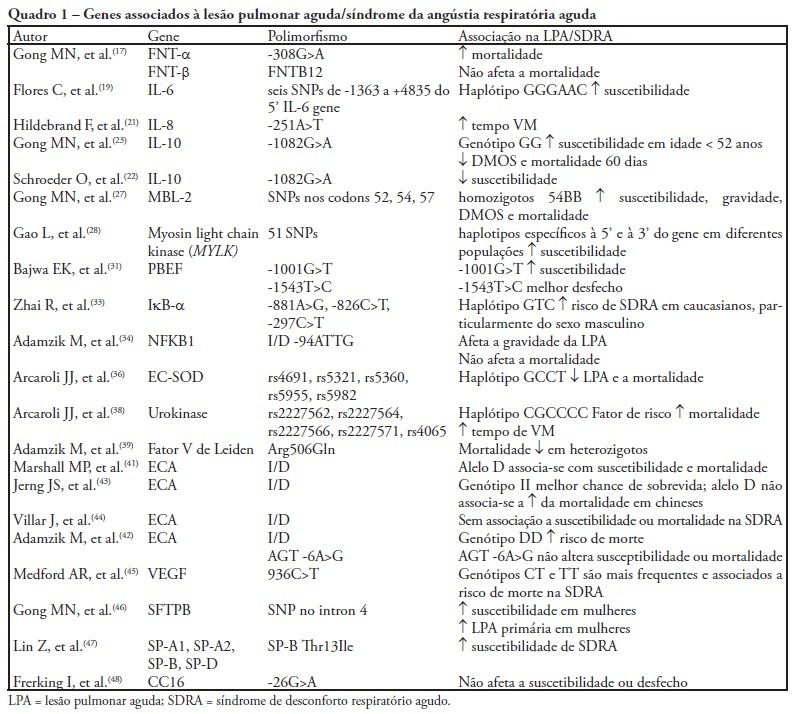Abstract
Rev Bras Ter Intensiva. 2009;21(4):416-424
DOI 10.1590/S0103-507X2009000400012
Acute lung injury and its most severe presentation, acute respiratory distress syndrome, are a common denominator for several diseases which can lead to exaggerated lung inflammation. In the last years this variability has been ascribed, at least partially, to genetic issues. This study aims to review the role of the main genes involved in acute lung injury and acute respiratory distress syndrome susceptibility, morbidity and mortality. By search on PubMed and LiLACS databases, using the key words acute lung injury, acute respiratory distress syndrome and adult acute respiratory distress syndrome in combination with genetic polymorphisms, 69 papers were selected, from which 38 were included in this review. Were also considered relevant articles extracted from the reference lists in the articles selected from the databases. Genetic polymorphisms are gene variations in at least 1% population. These gene variations may influence the inflammatory response mediators' expression, directly affecting the susceptibility to acute lung injury, the intensity of lung parenchyma inflammation, the development clinical course and outcome. Association studies reproducible in large populations will definitely allow genomics to be included into the diagnostic and therapeutic armamentarium for acute lung injury/acute respiratory distress syndrome patients.

Abstract
Rev Bras Ter Intensiva. 2009;21(2):197-203
DOI 10.1590/S0103-507X2009000200013
The acute respiratory distress syndrome is the clinical presentation of acute lung injury characterized by diffuse alveolar damage and development of non-cardiogenic pulmonary edema due to increased pulmonary alveolar-capillary membrane permeability. Alveolar recruitment maneuvers and prone position can be used in the treatment of acute respiratory distress syndrome. The objective of this review of literature was to identify possible benefits, indications, complications and care of the associated recruitment maneuvers and prone position for treatment of the acute respiratory distress syndrome. This national and international scientific literature review was developed according to the established criteria for searching the databases MedLine, LILACS, SciElo, PubMed, Cochrane, from 1994 to 2008 in Portuguese and English, with the key words: acute respiratory distress syndrome, alveolar recruitment maneuver and prone position. Despite advances in the understanding of acute respiratory distress syndrome pathophysiology, mortality is still expressive. Alveolar recruitment maneuvers and prone position significantly contribute to treatment of acute respiratory distress syndrome patient aiming to improve oxygenation and minimizing complications of refractory hypoxemia and reduction of pulmonary compliance. However,as there are few studies in literature associating alveolar recruitment maneuvers and prone position for treatment of acute respiratory distress syndrome, additional research and evidences of clinical application are required.

Abstract
Rev Bras Ter Intensiva. 2009;21(1):51-57
DOI 10.1590/S0103-507X2009000100008
Acute respiratory distress syndrome is characterized by an acute pulmonary inflammatory process induced by the presence of a direct (pulmonary) insult that affects lung parenchyma, or an indirect (extrapulmonary) insult that results from an acute systemic inflammatory response. It is believed that an efficient therapy for the acute respiratory distress syndrome should attenuate inflammatory response and promote adequate repair of the lung injury. This article presents a brief review on the use of stem cells and their potential therapeutic effect on the acute respiratory distress syndrome. This systematic review was based upon clinical and experimental acute respiratory distress syndrome studies included in the MedLine and SciElO database during the last 10 years. Stem cell transplant lead to an improvement in lung injury and fibrotic process by inducing adequate tissue repair. This includes alveolar epithelial cell differentiation,and also reduces pulmonary and systemic inflammatory mediators and secretion of growth factors. Stem cells could be a potential therapy for acute respiratory distress syndrome promoting lung repair and attenuating the inflammatory response. However, mechanisms involving their anti-inflammatory and antifibrinogenic effects require better elucidation, limiting their immediate clinical use in acute respiratory distress syndrome.
